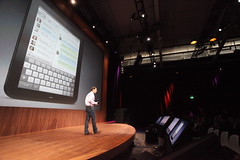 Yesterday, HP finally delivered an iPad competitor I can get excited about, not just by creating an elegant piece of hardware, but by taking a step back and outthinking their competition. Unlike the iPad, the TouchPad is part of a seamless technology ecosystem that also encompasses smartphones, PCs and printers, all running the same operating system and sharing through the same wireless infrastructure.
Yesterday, HP finally delivered an iPad competitor I can get excited about, not just by creating an elegant piece of hardware, but by taking a step back and outthinking their competition. Unlike the iPad, the TouchPad is part of a seamless technology ecosystem that also encompasses smartphones, PCs and printers, all running the same operating system and sharing through the same wireless infrastructure.
Printing, file-sharing, synchronization and even charging just work without cables or configuration. It’s clever stuff, and only a company like HP – with well-accepted products in virtually every technology market segment – could have pulled it off. Not only does the TouchPad run their recently-acquired WebOS; so do their Palm Pre phones, and so will their desktops and laptops.
Before the iPad, tablets were a jokey afterthought in the gamut of home devices, largely governed by Bill Gates’s pen-bound vision for how those devices should behave, and Apple’s previous failure with the Newton. With the iPad, Apple turned them into a must-have accessory that made most domestic computing tasks easier. The 3G version beat expectations by eschewing contracts, making mobile Internet use both more attractive and affordable. As soon as it launched, it seemed like a wonderful progression. I love mine: it’s been used to write code, fix servers, write and read articles, read entire novels, watch movies and kill time on the plane. It’s not that I couldn’t do without it. I wouldn’t want to – even despite the crashing applications, slow sync times and horrible iTunes user experience.
But competition in the market is healthy for consumers. It drives prices down, quality up, and gives us all choices. But for some reason, nobody’s managed to provide a satisfactory competitor to the iPad. This may relate to the app store model: because Apple takes 30% of all app store sales, it can sell its devices at a lower margin than its competitors. Android tablets, on the other hand, really need to use the Android Market, which is shared between them – and while cellphone carriers get a cut, tablet manufacturers don’t. That means, for example, that the Motorola Xoom will cost $799 – $300 more than the cheapest iPad. Because everyone expects the Apple device to be at the top end of the market, Android offerings need to be priced below it, particularly when they’re directly competing feature-for-feature. It’s beginning to seem like this might be impossible.
What’s cool about the HP offering is that it doesn’t just create competition: it actually makes the iPad look clunky, which is something nobody else has managed yet. What’s more, they have an Apple-like advantage in their homegrown App Catalog, and by including printers, they’ve brought ink cartridges into the pricing ecosystem, so the up-front cost should be low. The seamless wireless integration between devices makes it perfect for business as well as home use, and WebOS’s reliance on web technologies makes it attractive to developers like me.
That’s the key. It’s not just that I’m excited to use them; HP have made me excited about developing for WebOS devices. Taken in conjunction with Android’s growing dominance, not to mention the rumor of two new iPads before December, it’s going to be a very interesting year.
Photo: Jon Rubenstein introduces new HP TouchPad, by Robert Scoble. Shared under a CC license.
Leave a Reply